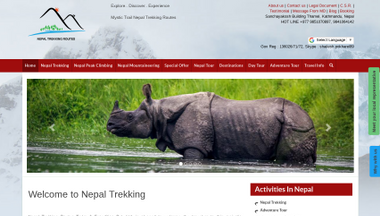Our friend Alan Arnette has written a thoughtful piece for Outside magazine examining the evolving landscape on Everest where the more expensive western guide services are now competing directly with low-budget, locally owned companies. This is having a major impact on the mountain and will likely play a significant role in future climbing expeditions there, but the question remains as to whether or not these operators are actually making the mountain less safe.
In the article, Alan provides some background and historical information about Everest and commercial guiding on the mountain. That started back in the 1990’s when mountaineering companies began offering clients the opportunity to scale the world’s highest peak but at a cost of as much as $65,000. Over the years, more operators joined the fray, which has led to the common perception that Everest is filled with rich people who pay someone to drag them to the top.
But in recent years, there has been a slew of new climbing companies that have begun guiding on the mountain too. Mostly owned by local Nepali guides, the companies offer cut-rate prices, often half the cost of the western operators. This has attracted large numbers of clients, with some of the budget operators now bringing as many as 100 people with them to Base Camp.
That alone doesn’t necessarily make the mountain less safe however, and Alan points out how Nepal could follow the lead of other countries around the world and make their mountains safer – most notably Denali in Alaska and Aconcagua in Argentina. But, because the Nepali government seems to make some perplexing moves and often appears to be more concerned with looking like its doing something rather than actually doing something, these actions aren’t likely to occur. Because of this, Everest runs the risk of becoming inherently unsafe with larger crowds, massive traffic jams, and budget operators that could potentially be cutting corners.
As the 2018 spring climbing season continues to wind up, and more and more teams are arriving in Base Camp on both sides of the mountain, this article serves as a great “big picture” view of current trends on the mountain. If you’re a fan of Everest and follow the happenings there closely, you’ll find some insights on where things have gone over the past few years and where they are probably going in the near future.
Needless to say, things are probably going to get more complicated and crowded before they get better. With the genie out of the bottle, there is probably no going back.
Filed under: Adventure Travel, Climbers, climbing, Everest, Expedition, Himalayas, Kraig Becker, mountaineering, Nepal, Tibet | Tagged: Cho Oyu, Climbers, Dhaulagiri, Everest, Expedition, Kanchenjunga, Kathmandu, Khumbu region, Lhotse, Lukla, Makalu, Manaslu, Mountain Sherpa Trekking and Expeditions, Namche Bazaar, Nepal, Peak Climbing, Travel, trekking | Leave a comment »


































